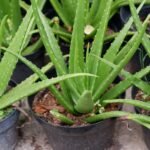Spotting different types of trees in the wildlife can prove to be a fun adventure. But you must know that it is not always easy for us to be able to tell the difference between them. One such tree is the cherry (or Prunus Avium) tree which has unique leaves that will help you to identify it. The wild cherry tree leaves are oval-shaped along with pointed tips as well as a smooth edge. They are bright green in summer and spring, further turning red or yellow in fall. Paying attention to such minor details will help you to easily identify them.
Table of Contents
ToggleHow Do The Leaves Of A Wild Cherry Tree Look Like?
Learning to identify them is fun and easy. By looking at a few features, you can spot these trees in nature without any trouble.
Surface Texture
The leaves of this tree feel smooth and shiny on the top. But if you touch the underside, it feels a bit rough due to tiny hairs. The top side is dark green, and the bottom is lighter with a soft and fuzzy feel.
Margin
The edges of these leaves are not smooth but have sharp and small teeth, like a saw. Moreover, these teeth are regular and evenly spaced as well. Hence, these margins will help you to easily identify the leaf.
Petiole Features
The petiole (or stem that holds the leaf) is thin and can be 2 to 6 centimeters long. Furthermore, it is green at first but might turn red as the year goes on. The petiole is flexible and shiny which makes it easy to spot.
Seasonal Changes
In the spring and summer seasons, the leaves are dark green and shiny. In the fall season, they change color to yellow, orange, or red before falling off. This color change further makes the tree unique from other trees, especially in autumn.
Bark and Flowers
The bark of a Prunus Avium tree is smooth and reddish-brown or gray and peels in thin strips. In the spring season, the tree grows small, and white flowers come in clusters. These flowers appear before the leaves and have a sweet scent.
With practice, you’ll be able to recognize the leaves of a Prunus Avium tree using these ideas. Knowing these simple traits will help you appreciate nature when you are exploring nature.

What Are The Health Benefits Of Cherry Leaves?
These leaves are useful and full of natural benefits. They are famous for improving the environment and health. Here are the core health benefits of using leaves of cherry tree:
- Respiratory Health – It helps soothe dry coughs and ease mucus which makes them useful for chronic coughs, especially those that disturb sleep.
- Digestive Support – Prunus Avium leaves also stimulate digestive juices and improve food breakdown & nutrient absorption. Moreover, it reduces indigestion symptoms by toning the digestive system.
- Heart Health – They also support circulation and ease heart irritation. Furthermore, it helps to manage palpitations and promote heart health as well.
- Anti-inflammatory Properties -With antioxidants, these leaves reduce inflammation. As a result, it benefits conditions like gout, allergies, and other heat-related issues.
- Skin Health – Applied to the skin, these leaves reduce inflammation and soothe irritation. Also, it helps with eczema, rashes, or puffy eyes.
Using the leaves of a cherry tree can help your health and the planet. They are simple, natural, and a great way to enjoy the benefits of nature every day.
Tips To Use The Cherry Tree Leaves In Our Daily Lives
These leaves can be more useful than you think. From making tea to using them in crafts, there are many simple ways to add these leaves to your daily life.
- Herbal Teas – Start by completely drying the leaves and then steeping them in hot water for nearly 10 to 15 minutes. This tea helps soothe coughs and improves digestion with its natural properties.
- Poultices for Wounds – Crush fresh leaves and apply them to minor cuts or irritations. They work as a natural astringent, reducing inflammation and promoting healing.
- Flavoring Agent – Use the leaves to flavor syrups, jams, or desserts. Their unique taste adds a cherry-like essence to food and drinks.
- Natural Remedies – Add wild cherry leaves to homemade cough syrups. Their soothing properties are great for relieving dry coughs.
- Infused Oils – Steep dried leaves in a carrier oil for weeks to create infused oil. You can use this oil in skincare or for soothing muscle pain.
With a little creativity, you can use cherry tree leaves in many ways. For better health, these leaves offer natural ideas to make your everyday life better.

Summing It All Up
Recognizing different trees in nature can be a fun and rewarding activity. One interesting tree to identify is the wild Prunus Avium tree, known for its unique features. Its leaves are oval with serrated edges, shiny green on top, and fuzzy underneath. They turn vibrant orange, pink, or red in autumn.
These leaves are not only helpful for identification but also offer health benefits. These benefits include soothing coughs, improving digestion, and reducing skin irritation. Wild cherry trees also have smooth reddish-brown bark and white flowers in spring. Learning these traits makes exploring nature more enjoyable and informative.
FAQ
Question. Where are cherry bushes found?
Answer. They grow in temperate regions that are filled with hedgerows and woodlands. It is also found in open areas with well-drained soil and plenty of sunlight.
Question. How tall can wild cherry trees grow?
Answer. These trees can reach 15 to 30 meters (50 to 100 feet) tall, depending on their environment and care.
Question. Are wild cherry berry trees edible?
Answer. Yes! The small cherries are completely edible. They are best used in jams, desserts, or syrups.







